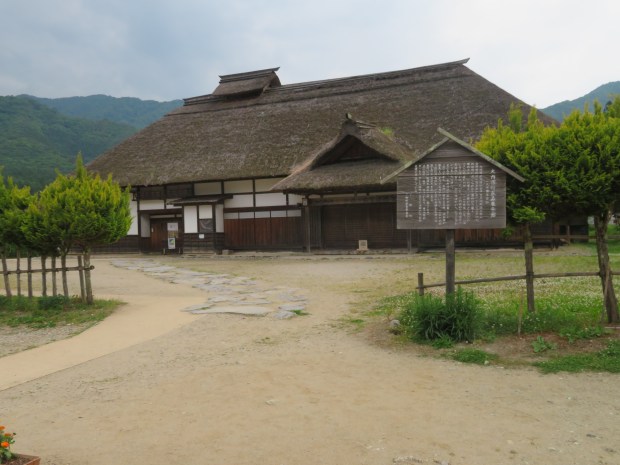During Japan’s Edo Period (1603-1867), the movement of people and goods was strictly controlled by the shogunate. Anyone wishing to travel was expected to apply for and receive permission to do so, and then to travel only on approved routes. Generally speaking, the only acceptable reasons to travel were for trade or religious purposes or, in the case of daimyo (feudal lords of the period), for purposes of the sankin-kotai (alternate residence) system set up by the shogunate to maintain control.
At regular intervals along the approved routes post towns (juku) were established to provide food, drink and accommodation to sanctioned travelers. Many juku had honjin, buildings designed specifically to provide accommodation to government representatives, who often stayed a few days at various juku to conduct official business such as tax collection or dispute resolution as they traveled.
The Tokaido and Nakasendo routes running between Kyoto and Tokyo (then known as Edo) are the best known of these “highways”, but there were many more fanning out in all directions from Edo. One of the lesser routes, the Shimotsuke Kaido (sometimes called the Nishi Aizu Kaido), extended the Nikko Kaido from Nikko, site of the famed Toshogu Shrine, north to Aizu (now Aizu-Wakamatsu) and other interior domains further to the north. This route passed through some rugged mountains but was still a popular “shortcut” for those traveling between the northern interior and the capitol.
Once modern travel methods were introduced, this mountain route was largely abandoned and the area became a bit of a backwater. This has proven to be a bit luck for modern travelers in search of old, traditional Japan, as one of the post towns on the Shimotsuke Kaido, Ouchi-juku, still looks much as it did during the Edo Period.

Nestled in a valley, the center of the town is a 500 meter long street of thatched houses, all with hipped roofs that make them look squat and heavy. Between the houses and the unpaved street are channels of fast-flowing water from the nearby mountains, with occasional “landings” where locals would traditionally draw water for their daily needs.
Near the center is a honjin, reconstructed to look like the original, which was the victim of fire in the 20th century. It houses museum displays relating to travel in Edo Period Japan and the role of honjin in official travel.

The town is popular with day trippers from Nikko or Aizu-Wakamatsu, although there are three minshuku in the town offering overnight accommodation as well as other inns in the nearby hot springs town of Yunokami Onsen, also site of the nearest train station.
Visitors can freely wander the old street and soak up the atmosphere. There are a number of souvenir shops, many offering traditional wooden toys and other handicrafts of the area as well as local food specialties.
There are also a few eateries, most featuring the most famous dish of this area, a bowl of noodles known as “negi soba” because it is served with a single stick of leek (“negi“). Diners are encouraged to use this leek to pick up and eat the noodles, biting off a bit of the raw onion with each mouthful of noodles. Certainly this method of eating noodles gives the noodles an especially zesty flavor.
Visit in early summer, as I did, and you may be lucky enough to see locals busily installing fresh thatch on one of the roofs. While there are few people left these days who know the art of thatching, according to one local, when a new roof is needed and the onset of the rainy season is imminent, everyone in town pitches in to help.
Ouchi-juku has one other potential appeal to Western visitors with a particular interest in history. Isabella Bird, Victorian traveler/travel writer, stayed overnight on June 27, 1878, when traveling north from Nikko on her way to Hokkaido. She writes in her travelogue, Unbeaten Tracks in Japan:
“The country was really very beautiful. The views were wider and finer than on the previous days, taking in great sweeps of peaked mountains, wooded to their summits, and from the top of the Pass of Sanno the clustered peaks were glorified into unearthly beauty in a golden mist of evening sunshine. I slept at a house combining silk farm, post office, express office, and daimiyô’s rooms, at the hamlet of Ouchi, prettily situated in a valley with mountainous surroundings and, leaving early on the following morning, had a very grand ride…”
Although Bird did not identify the name of the house or the people she stayed with, apparently the Abe family have always had charge of the local post office/express office (they still do!) and therefore claim the honor of having hosted her. Their home was built between 1865 and 1868, so would have been only a decade old at the time of Bird’s stay.
There are lots of nooks and crannies to explore in Ouchi-juku as visitors soak up the atmosphere and imagine themselves in 19th century Japan. It is a history buff’s delight.
© 2021 Jigsaw-japan.com and Vicki L. Beyer
We’re thrilled if you share this; if you want to re-use in any other way, please request permission.














